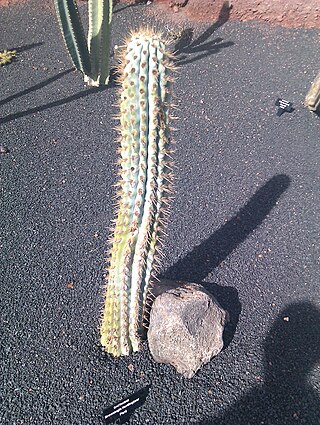
Cleistocactus strausii, the silver torch or wooly torch, is a perennial flowering plant in the family Cactaceae. It is native to mountainous regions of Department Tarija, Bolivia, at 1,500–3,000 m (4,921–9,843 ft).

Yungasocereus is a monotypic genus of cacti. Its sole species is Yungasocereus inquisivensis, native to Bolivia.

Cleistocactus winteri is a succulent of the family Cactaceae. Its common name is the golden rat tail. Cleistocactus winteri subsp. colademono, as its synonym Cleistocactus colademononis, has gained the Royal Horticultural Society's Award of Garden Merit.

Lobivia backebergii is a species of flowering plant in the cactus family Cactaceae, native to eastern Bolivia and southern Peru.

Cleistocactus morawetzianus is a species of columnar cactus in the genus Cleistocactus, endemic to Peru.

Cleistocactus tominensis is a species of columnar cactus in the genus Cleistocactus, endemic to Bolivia, where it is found in forests, on cliffs, and in inter-Andean valleys at altitudes of 900 to 2,200 meters.

Haageocereus pseudomelanostele is a species of Haageocereus found in Peru

Cleistocactus smaragdiflorus is a species of Cleistocactus found in Bolivia and Argentina.

Browningia hertlingiana is a species of Browningia found in Peru.

Matucana formosa is a species of Matucana found in Peru.

Matucana weberbaueri is a species of Matucana found in Peru.

Matucana ritteri is a species of Matucana found in Peru.

Loxanthocereus acanthurus is a species of Loxanthocereus found in Peru.

Matucana oreodoxa is a species of Matucana found in Peru.

Cleistocactus buchtienii is a species of columnar cacti in the genus Cleistocactus.

Weberbauerocereus winterianus is a species of Weberbauerocereus from Peru.

Haageocereus acranthus is a species of Haageocereus found in Peru.

Lobivia tegeleriana is a species of Lobivia found in Peru.

Loxanthocereus sextonianus is a species of Loxanthocereus found in Peru.
Weberbauerocereus churinensis is a species of cactus in the genus Weberbauerocereus, native to Peru.





















